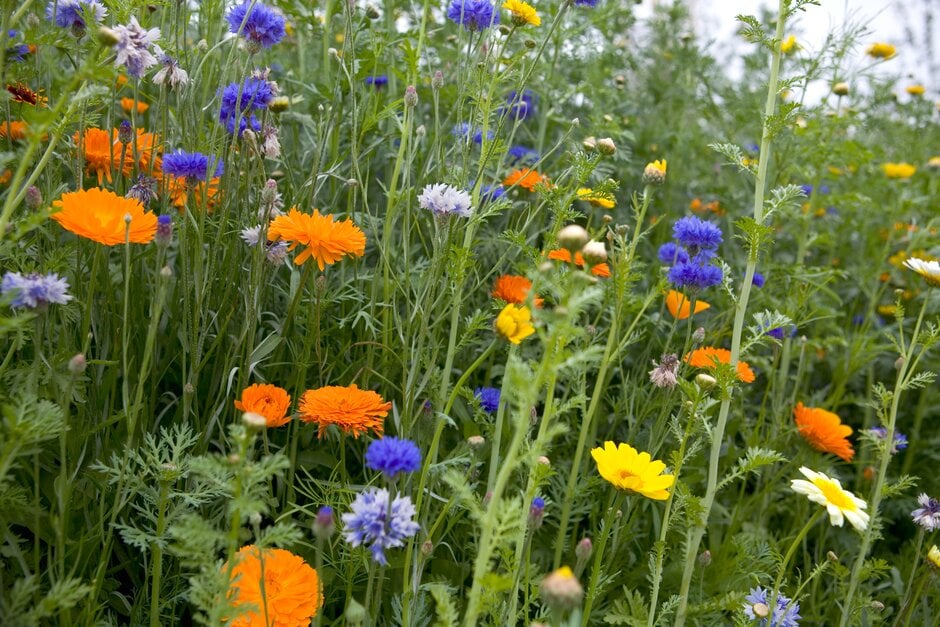How to sow seeds outdoors
Sowing seeds outdoors is an easy and inexpensive way to grow a wide range of plants. It’s ideal if you don’t have a greenhouse or much space to grow seedlings on windowsills.

Quick facts
- Sowing seeds outdoors straight into the soil is known as ‘direct sowing’
- Seeing weed seedlings appear in spring is a sign that the soil is warm enough to begin direct sowing
- Direct sowing seeds is an environmentally friendly way to fill your garden; with no need for pots or compost
- Sowing directly outside is suitable for many ornamental and edible plants, especially those like poppies that resent root disturbance
- Generally, the smaller the seeds, the shallower you should sow them
Jump to
Getting started
Spring is an ideal time for direct sowing many seeds, but some can be sown during summer and autumn. Check seed packets for the recommended times of when to sow outdoors.
Seeds can be sown directly in drills (rows) or broadcast (scattered over the soil surface). Sowing in drills makes it easier to distinguish your
Broadcast sowing is suitable for small seeds, seed mixes, and where you have a large area to sow, such as an annual meadow. Mixing the seeds with sand makes it easy to see which areas you’ve already covered.
With large seeds that need wide spacing, it’s not necessary to make a drill – seeds can be inserted into the soil after making a hole to the required depth with a cane,
What you will need to sow outdoors:
- A border fork – if compacted soil needs loosening
- A hand or border fork for weeding
- A landscape rake
- A draw hoe or cane/stick to make drills
- A string line or bamboo
cane - A dibber or cane to make holes for large seeds
- Sand to mix with fine seed when broadcast sowing
A simple guide to sowing seeds outdoors
-
Prepare your soil
Remove weeds and large stones and fork over the soil if it is compacted. If the soil has recently been forked or dug over, or if it is newly added soil, lightly tread over the area once. Rake the soil until it has a fine, crumbly texture, with a flat (ideally level) surface.
-
Broadcast seed
Add sand to your seeds and scatter the mixture evenly across the prepared ground, moving your hand across the area in different directions. A 50/50 mix of sand and seeds is particularly useful when sowing small seeds. Lightly rake the soil in the area you have sown to bury the seeds and then move on to step 7.
-
Make drills
Use a hoe, cane or stick to make a drill. If you want straight rows, use a string line or bamboo cane on the soil to guide you. Check the seed packet for the recommended sowing depth, or follow the general rule of sowing at a depth of about two or three times the size of the seed, to determine how deep the drill needs to be. If sowing more than one row, check the seed packet for the recommended spacing between rows.
-
Water along the drills
Dampen the base of the drills to encourage germination and ensure moisture is readily available for emerging roots.
-
Sow the seeds
If the seeds are large enough to pick up individually, simply place them along the base of your drill at the recommended spacing on the seed packet. If they are tiny, take a pinch of seeds and drop them as thinly as you can along the drill.
-
Cover the drill
Rake soil back over the drill to cover the seeds and firm it down with the back of your rake.
-
Keep a record
Place a plant label at the end of the drill, or in the corner of the area you broadcast, recording the plant and date of sowing. Birds sometimes like to remove plant labels, so keep a record in a notebook too and insert canes/sticks at either end of your drills as markers.
-
Water the soil where seeds have been sown
Water to settle the soil and seeds. Use a watering can with the rose upside down or a hose with a fine spray to avoid disturbing the soil.
Aftercare
Seedlings usually appear within a couple of weeks but consult the seed packet for exact timings. They can be vulnerable in the first couple of months, until sturdy and well-rooted. Check them every few days to ensure they have sufficient water, are not being outcompeted by weeds, and are not being attacked by insects, slugs or snails. Covering seedlings with fine mesh protects them from many insects.
Overcrowding can hinder growth and make seedlings more susceptible to disease, so thin them out if necessary. This is best done when they are still small, to limit any disturbance to the remaining seedlings. Use your thumb and forefinger to gently tug approximately every second or third seedling out of the soil, to leave the remaining at the recommended spacing.
Hardy seedlings should cope with light frosts, but keep biodegradable horticultural fleece or cloches handy and cover them if a hard frost is forecast.
A video guide to sowing seeds outdoors
Get involved
The Royal Horticultural Society is the UK’s leading gardening charity. We aim to enrich everyone’s life through plants, and make the UK a greener and more beautiful place.